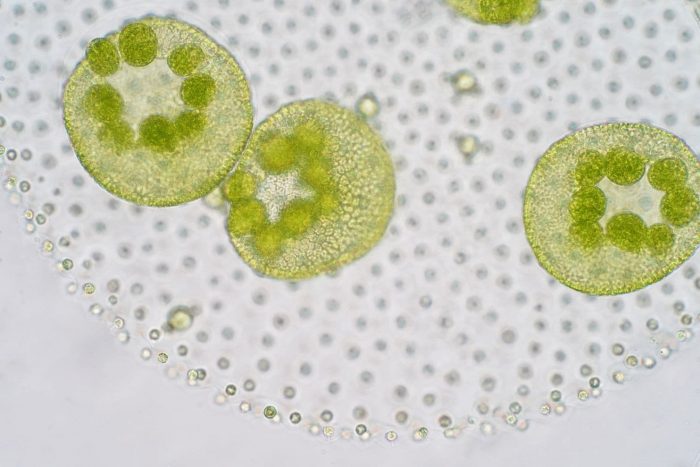ICYMI: Highlights from the week that was May 19 – May 25, 2019
No one can keep up with everything, so let us do it for you. We’ll gather the top Smithsonian stories from across the country and around the world each week so you’ll never be at a loss for conversation around the water cooler.
This week we learned of smart trees that are trying to save the planet and tiny fish that sacrifice themselves to save coral reefs. A House panel voted to bump the EPA’s budget so maybe we humans can get on board, too.

Where does the oxygen we breathe come from?
If you guessed “trees,” you’re in for a surprise.
The Washington Post, May 20

Phytoplankton, which are found on the surface of lakes and oceans, come in a variety of shapes and sizes. (Getty Images/iStockphoto)
Take a deep breath. And then another. One of those breaths came from trees. But the source of the other breath might surprise you.
“Around 50 percent of the oxygen we breathe comes from phytoplankton,” said Brenda María Soler-Figueroa, a marine biologist at the Smithsonian Environmental Research Center.
Phytoplankton are tiny creatures that live on the surface of oceans and lakes. Each one is invisible to the naked eye, but when they gather together in great numbers, they can turn a body of water red, green or milky white based on which variety is present. Read more from the Washington Post’s Kid’s Post.
Smart trees are learning to stand between humanity and disaster
The environment, in many ways, is keeping pace with human industrialization. But will it last?
OZY, May 20

Getty Images
Since humans came out of the trees and started chopping them down to make fire and houses, we’ve removed about 46 percent of the world’s forests. That’s a tragedy for bird habitats and aesthetics alike, but it turns out it’s also a tragedy for humankind.
Forests — along with other plants, soil and oceans — serve as carbon sinks, places where the planet-warming carbon emitted by humans is absorbed and neutralized. In 2018, it was estimated that humans produced about 37 billion tons of carbon dioxide from burning fossil fuels, an all-time high … and an increase of about 60 percentsince 1990. Historically, about half of those emissions stayed in the atmosphere while the other half was absorbed into forests and oceans. And it turns out that despite humanity’s skyrocketing emissions …Read more from OZY.
How Wild Should We Let the Solar System Be?
Experts argue that more than 85 percent of the solar system should be left untouched so that we can sustainably move off-world
Scientific American, May 21

Credit: Saul Loeb Getty Images
Space, as Douglas Adams so aptly put it, is big. Compared with the confines of our own planet, the solar system’s expanse is absurdly huge. The idea that we could deplete its vast reserves seems almost laughable.
Amazon CEO Jeff Bezos touched on such sentiments on May 9, during a speech unveiling Blue Moon, his spaceflight company’s lunar lander. “If we move out into the solar system, for all practical purposes, we have unlimited resources,” the billionaire said.
Yet a recent study suggests that at current growth rates, humanity could practically exhaust the most accessible riches in our stellar neighborhood within less than five centuries. To prevent an interplanetary economic crisis, the study’s co-authors suggest that our civilization must somehow build sustainable practices into our expansion out to space, potentially setting aside more than seven eighths of our stellar system’s off-world “real estate” as protected wilderness. The findings appear in the journal Acta Astronautica. Read more from Scientific American.
Watch Jay Park Accept Game Changer Award & Perform at Smithsonian Celebration of Asian Pacific Americans
Billboard, May 21
On Saturday evening (May 18), the Smithsonian Asian Pacific American Center held its first annual event in Los Angeles to raise awareness about the many contributions of APAs, announce the Smithsonian Asian Pacific American Keystone Initiative and raise funds for a permanent Asian Pacific American gallery at the Smithsonian.
One of the four honorees of the night was Jay Park, who was presented with the Game Changer award for his work as an artist, songwriter, choreographer and entrepreneur. “I’m going to continue to try to put on and continue to try to break barriers and push limits and remain humble and just be a good human being,” he said while accepting his award. He also treated the crowd to a five-song set, including tunes “Justin Bieber,” “All I Wanna Do,” “Mommae,” “K-TOWN” and “Yacht.” Read more from Billboard.
Trump taps former U.S. ambassador and space enthusiast to run Air Force
The Washington Post, May 21

Barabara Barratt, a former U.S. ambassador to Finland, presents former president Jimmy Carter the O’Connor Justic Prize in Phoenix in 2017 (Ross D. Franklin/AP)
President Trump is nominating Barbara Barrett, a former U.S. ambassador to Finland and onetime Republican candidate for governor of Arizona, to serve as the next secretary of the Air Force, tapping a longtime space enthusiast to run the service set to oversee the new Space Force.
Trump made the announcement Tuesday on Twitter, starting the clock on a confirmation process that will require Barrett to be approved by the Senate.
“I am pleased to announce my nomination of Barbara Barrett of Arizona, and former Chairman of the Aerospace Corporation, to be the next Secretary of the Air Force,” Trump wrote. “She will be an outstanding Secretary! #FlyFightWin.” Read more from the Washington Post.
Alabama Historians Say The Last Known Slave Ship To U.S. Has Been Found
NPR, May 22

Many of the survivors of the Clotilda voyage are buried in Old Plateau Cemetery near Mobile, Ala. The Alabama Historical Commission announced Wednesday that researchers have identified the vessel after months of work.
Julie Bennett/AP
The Alabama Historical Commission says a wrecked ship off the Gulf Coast is the Clotilda, the last known vessel to bring people from Africa to the United States and into bondage.
At the Robert Hope Community Center in Mobile, Ala., on Wednesday, researchers unveiled their discovery to descendants of the people on that fateful voyage. “They had been waiting for this for a long time,” Alabama Historical Commission Chairman Walter Givhan, a retired major general, told NPR. “They were jubilant.”
Givhan said researchers based their assessment on specific historical information. “You knew certain things about this ship, you knew it had certain characteristics just from the history — how many masts, how long it was, what kind of wood it might have been made of,” Givhan said. Read more from NPR.
Jim Handly Hangs Out With the National Zoo Sloth Bears
House panel votes to boost Interior, EPA budget by $1.7B
The Hill, May 22

A key House committee on Wednesday advanced the 2020 budgets for the Interior Department and the Environmental Protection Agency (EPA), voting to increase their funding by $1.73 billion over last year.
The Tiny Fish That Break a Fundamental Rule of Vertebrate Life

A Great Barrier Reef blenny (TANE SINCLAIR-TAYLOR)
Posted: 30 May 2019







